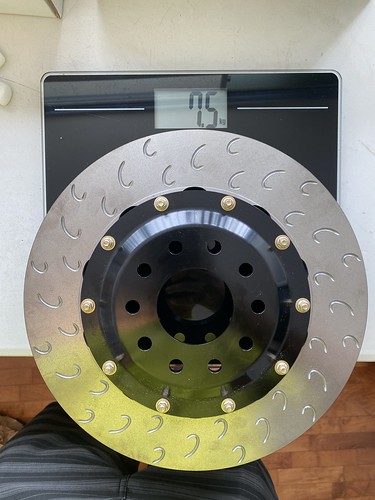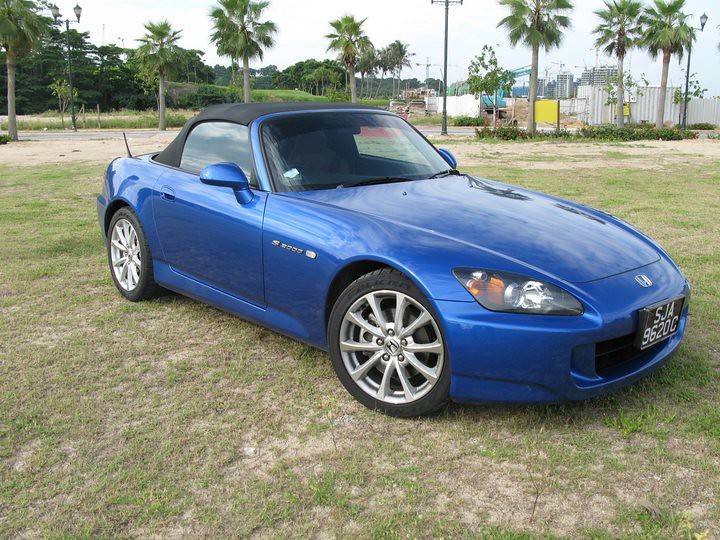Another long break from the previous post, work has been hectic but thankfully my efforts seem to be bearing some real fruit ultimately allowing me to look into the brakes on the S2000. Since my first foray onto the track, I've been reliant on upgraded brake pads on the stock calipers. The clear favorite for me has been the Project Mu Racing 999 with it's excellent characteristics when hot and feel during threshold braking. I've managed to stave off brake pad & fluid during track with custom brake ducts channeled to both disc and caliper on each corner. This has worked tremendously with virtually no brake fade after many laps at a go, what seems like extended brake pad life, extended brake fluid life, little to no instance of brake disc cracking and apparent long life of the rear hubs which are prone to failing due to heat soak from the solid rear disc.
Ultimately when I chose to upgrade my wheels, the consideration to move to a big brake kit was key in my selection of the face of the wheel. The Enkei Racing GTC02 wheel has generous convex curved spokes which allow enough clearance for a big caliper despite a slightly higher offset than my previous GTC01. Some barrels are also narrower around the hub but the GTC02 has plenty of space for me to maximize the disc diameter.
Sourcing for a brake kit for the S2000 comes with a few considerations even after the wheel selection issue has been resolved.
A) There are no front and rear big brake kits sold jointly to ensure optimal brake balance is maintained. Rear big brake kits usually eliminate the handbrake which is not suitable for road going cars. This leads to people having to buy a brake kit for the front and trying to custom something for the rear as well as playing around with brake pad compounds in an attempt to optimize brake balance. Most rear brake kits consist of stock bigger rotors from other cars combined with an Mazda RX7 or RX8 brake caliper. Clearly this variable of brake balance is an important attribute to maintain as the S2000 has excellent stock brake balance for trail braking in my view.
B) Brake cooling even with a big brake kit can be an issue as evidenced by the experiences of a friend of mine who was on an Alcon big brake kit with 330mm discs experiencing fade on race pads just after 5 laps. The larger diameter discs of the big brake kit do help but even with much larger vanes than the OEM rotors, one can easily begin running into the upper limits of the heat capacity of the system.
Ducting then becomes a necessity to stave off brake fade over multiple laps but running the ducting then has its own issues of which I have had my fair share of negative experiences over the years. At full lock, there is the tendency to crush and rub the brake cooling hoses until they eventually fail which leads to dragging of pipes everywhere. Being rather low, the S2000 also would quickly end up having ducting get damage from items on the road or collect gravel during an off track excursion which ends up obstructing the funnels or getting lodged in the piping.
In this picture you can see the brake duct piping dangling from my car after being damaged in an off track excursion.
C) The S2000 in naturally aspirated form doesn't put out too much power so balancing the braking needs with weight is also a key consideration. Some brake upgrade kits use large OEM discs from other cars but both such calipers and discs are usually heavy which is to be avoided considering how adding unsprung weight is detrimental to both braking and acceleration.
All things considered, much like any part of setting up a car, performance is a balance of resources available as well as limitations. Considering all these factors, here are some of the outcomes I sought in my choice of brake kit:
i) To seek a brake setup that has been proven in competitive events for reliability and endurance. This helps me minimize the risk of brake failure which is highly dangerous for obvious reasons. In this department, I also want to reduce the reliance of unnecessarily complicated ducting which I've had come loose far too many times. Getting brake ducting components which have come loose stuck in my brakes would not be my idea of a good time.
ii) To look for a brake kit that has good brake balance balancing the changes made to braking power. This will allow me to exploit the strength of the S2000 in its cornering ability in areas like trail braking.
iii) To consider the availability of replacement parts for service life. A slightly overlooked point has been how easily available spares are and with the age of the S2000, it's become more front of mind. Certain brands start off at a cheaper price point but longer term users of these brands now face a potential issue of lack of supply of replacement parts due to supply chain disruptions or even the winding up of the brand itself.
iv) Having used my previous brake setup which allowed me 10-15 laps of fade free performance, I've thoroughly appreciated how more fuss free seat time helped me get improve. I definitely am looking to find a brake kit that can keep me on the track for a similar amount of time without succumbing to the heat buildup. This attribute is something I would be willing to sacrifice some amount of reduced outright performance for.
With these points in my mind, the Sakebomb Garage AP Racing Competition Brake System https://www.sakebombgarage.com/ap-competition-brake-system-s2000/ and the Competition Rear Brake System https://www.sakebombgarage.com/sbg-competition-rear-brake-system-s2000-rear-rx8-caliper-retrofit-kit/ ticked every box in my book.
Here's how the front looks
Pics of the rears
Friend of mine from Japan helped me get these used RX8 calipers which are in great condition at a solid price!
I chose the N35S / CC43 pads which came recommended by a friend who has run these.
The performance upside realized from this entire braking setup would be:
1) An unsprung weight saving of about 1 kg per side up front.
2) From feedback from a bunch of users, no need to run any ducting front or rear if I'm just running the usual roughly 30 min runs that I make. This massive heat capacity increase benefits fluid, pad and disc lifespan as well as the performance of all these areas. From a safety aspect, this is pretty much priceless.
3) Great reliability of a proven brake system in both caliper & disc performance. Cracking discs or stuck calipers would probably be a thing of the past.
4) Readily available spares for all components of the brake system from disc, to caliper hardware and brake pads. Spares are also reasonably priced and upsizing of the components means the replacement cycle is not so frequent.
My car is currently in the midst of the full refresh of performance and I'm eagerly awaiting the completion of the entire car to experience the new lease of life it's been given. Upgrading the braking system was pretty much essential to being able to extract as much of the full performance potential of my S2000 as I can and has been long overdue.
Thrilled to move to the next chapter of performance!


















































